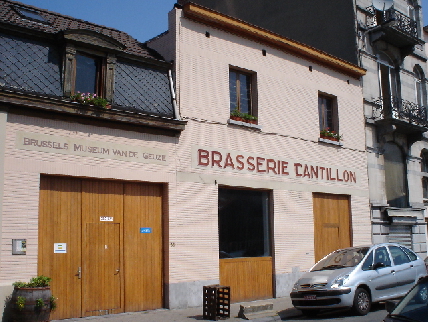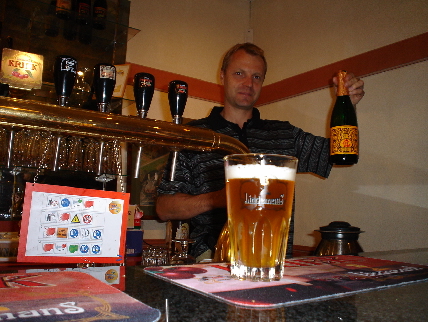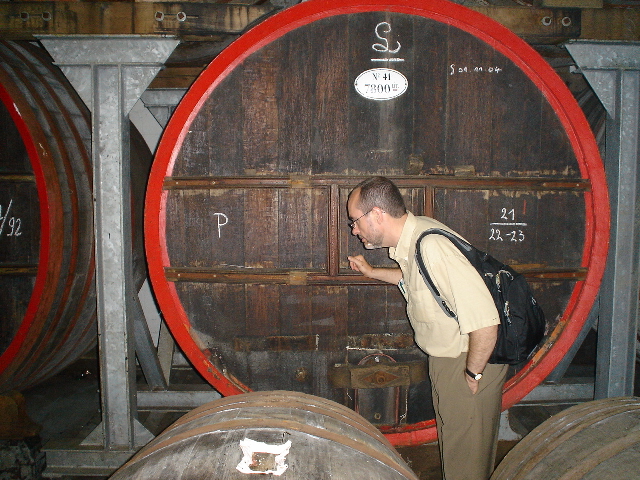|
|
Almost
anyone who knows anything about beer will have the knowledge that wheat
beers are a refreshing choice for the summer months. However,
only beer connoisseurs are usually familiar with the most bizarre wheat
beer in the world. These ancient Belgian ales are known as
Lambics, and they are one of the world’s most idiosyncratic, complex,
and elemental beer styles that are still commercially available.
Lambics are produced only in a small region of Belgium known as
Payottenland. These beers are produced without any additions of
cultured yeasts, and fermentation relies solely on the microbes that
reside in the atmosphere around Brussels and in wooden fermenting
barrels. Lambics are usually dry, sour golden ales that contain
only 4-6% alcohol by volume and are made with a large portion of raw
wheat. Many Lambics are aged for months or years in wooden
vessels. Sometimes Lambics from different years are blended (like
fine wines) to produce a special vintage ale called Gueuze (pronounced
GERZ). Often times there are additions of fruit and sugar.
Lambics have the refreshing sparkle of a fine champagne and the earthy,
oxidized character of a classic sherry – the best qualities of two of
the world’s most appetizing drinks in one beer.
Lambics are typically produced in rustic Belgian farmhouse breweries in
the cooler months of the year. Disruptive yeasts of summer play havoc
with Lambic fermentation. European malted barley and unmalted
wheat are crushed and mixed with warm water to produce a sweet golden
liquid (called wort) that is boiled along with aged hops. Most
brewers use fresh, fragrant, green hops for maximum hop aroma, flavor
and bitterness. Lambic brewers don’t want any of this in their
beer, so the hops are aged for years to remove the flavors and
aromas. The aged hops only add preservative acids and resins to
the Lambic brews. The liquid is cooled in shallow vessels under
open windows, and wild yeasts and bacteria settle into the wort
overnight to begin the magic process of fermentation. The young
Lambic is then transferred into large wooden barrels where fermentation
and aging continues. Most Lambics are bottled unfiltered, and the
leftover yeast consumes tiny amounts of residual sugar and builds up
pressure and natural carbonation inside the bottle. This is
definitely the “old school” method of beer production.
As rare and archaic as these beers sound, there are many classic
examples available in the Athens market. The most popular of
which comes from the Lindemans Brewery in a small village just outside
Brussels. Lindemans is famous for its production of popular,
non-traditional, fruit Lambics that are pasteurized and
sweetened. Their sweet, dessert-like raspberry Lambic (Framboise)
is their biggest seller in the United States and is followed closely by
versions called Kriek (with cherry juice) and Peche (with
peaches). A more acidic version of an apple Lambic called Pomme
has just hit the shelves of fine package stores in Georgia this
spring. There is even a very interesting Lindemans brand that is
combined with bold additions of black currants (Cassis). Because
of their sweet nature, Lindemans’ beers are the best choices for people
who are just beginning to explore the wild world of Lambics.
In stark contrast to the sweet Lindemans offerings are the earthy,
complex, intensely sour Lambics from Brussels’ Cantillon Brewery that
was founded in 1900. Jean-Pierre Van Roy married a daughter of
the Cantillon founder and took over brewing responsibilities in
1978. By refusing to pasteurize or sweeten his products for the
mass market, John-Pierre has become known as a true Lambic
traditionalist and inspiration for other brewers. Cantillon beers
are carbonated naturally in the bottle by living yeast and exhibit a
robust sparkle and thick foam when poured. Most fine beer stores
in Athens and Atlanta will also have a supply of Cantillon’s Rose de
Gambrinus Lambic that has a bountiful addition of tart raspberries (and
a racy label with a painting of Gambrinus sporting a saucy lady on this
lap). Cantillon Lambics are refreshing but deeply intense –
definitely an acquired taste for many.
The middle of the Lambic road is occupied by Frank Boon’s beers from
Lembeek, Belgium. Frank Boon purchased a crumbling old brewery 30 years
ago, and everyone thought he was insane. He is now one of the
most popular Lambic brewers in the world and produces flavorful
examples of Gueuze and fruit versions (such as his popular Kriek made
with 200 grams of real cherries in each bottle and refermented in the
bottle with no added sugar). The Boon Framboise beer is
especially delectable and is packed with prominent flavors of fresh
raspberries.
Lambics typically are offered in 355 and 750-ml bottles. Most of
them are corked like champagne and have foiled tops. To get the
most flavor from your Lambic experience be sure to serve around 55
degrees Fahrenheit and pour slowly into a tall glass or champagne flute
leaving an ounce or so in the bottom of the bottle (this keeps the
yeast sediment out of your glass). Lambics are extremely complex
(yet very refreshing) and make for a tantalizing aperitif beverage
right before a summer meal of chicken, shrimp or fish. Beer
lovers will say that a great Lambic will exhibit aromas and flavors of
wheat, fruit, vinegar, sherry, leather, almonds, minerals, vanilla, oak
and even horse blanket. Try not to be “put off” by the explosive
first taste of a fine Lambic, as subsequent sips tend to be mellower on
the palate.
Lambics are truly “strange brews” that don’t usually allow middle
ground. Most people either love or hate them from the
start. One thing is certain – no beer lover should miss the
experience!

 Left: The
Cantillon Brewery and Gueuze Museum in Brussels
Left: The
Cantillon Brewery and Gueuze Museum in Brussels
Right: Dirk Lindeman
serves up a Cuvee Renee unsweetened Gueuze in the Lindemans Brewery
tasting room.
|


